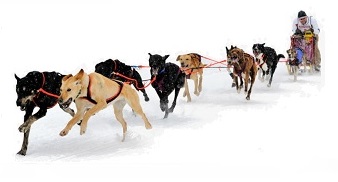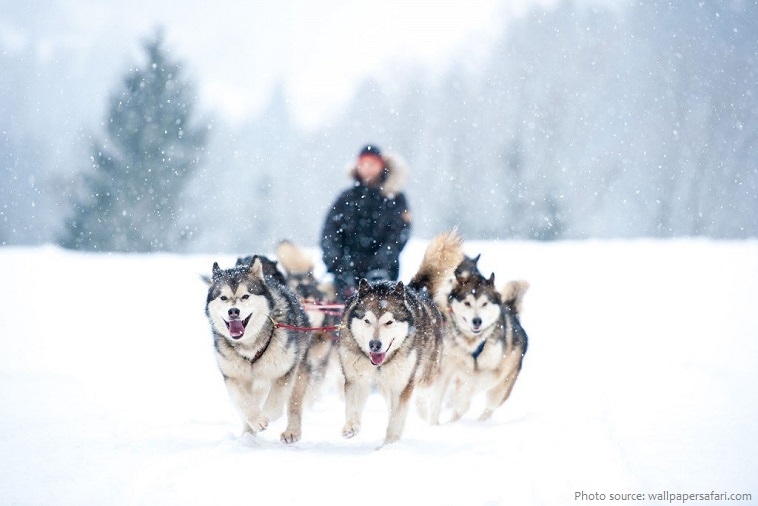
A sled dog is a dog used in Arctic climates to pull a sled across snow and ice.
The breeds most commonly associated with this work are the Siberian husky, Alaskan Malamute, Samoyed, Eskimo dog, and Laika — all large, powerful dogs with thick coats and high endurance.
The original sled dogs were chosen for size, strength and stamina, but modern dogs are bred for speed and endurance.
Most sled dogs weigh around 25 kg (55 lb), but they can weigh as little as 16 kg (35 lb), and can exceed 32 kg (71 lb).
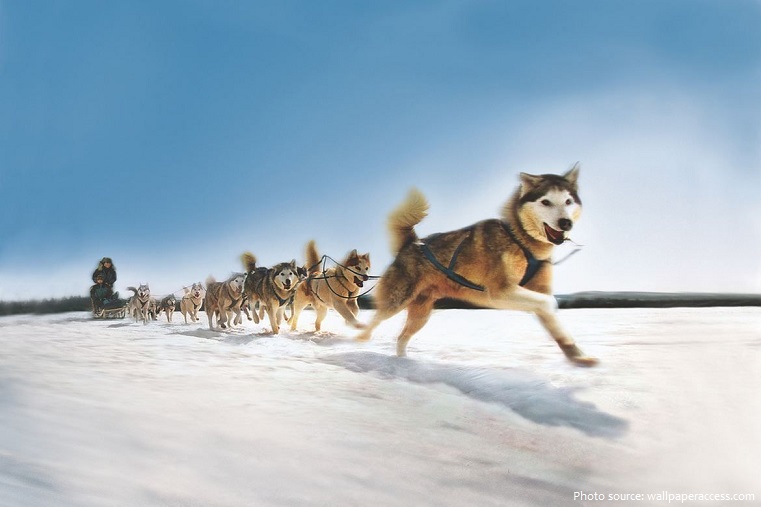
Sled dogs have a very efficient gait, and “mushers strive for a well balanced dog team that matches all dogs for both size (approximately the same) and gait (the walking, trotting or running speeds of the dogs as well as the ‘transition speed’ where a dog will switch from one gait to another) so that the entire dog team moves in a similar fashion which increases overall team efficiency.” They can run up to 45 km/h (28 mph). Because of this, sled dogs have very tough, webbed feet with closely spaced toes. Their webbed feet act as snow shoes.
Sled dogs have been used in the Arctic for at least 8,000 years and, along with watercraft, were the only transportation in Arctic areas until the introduction of semi-trailer trucks, snowmobiles and airplanes in the 20th century.
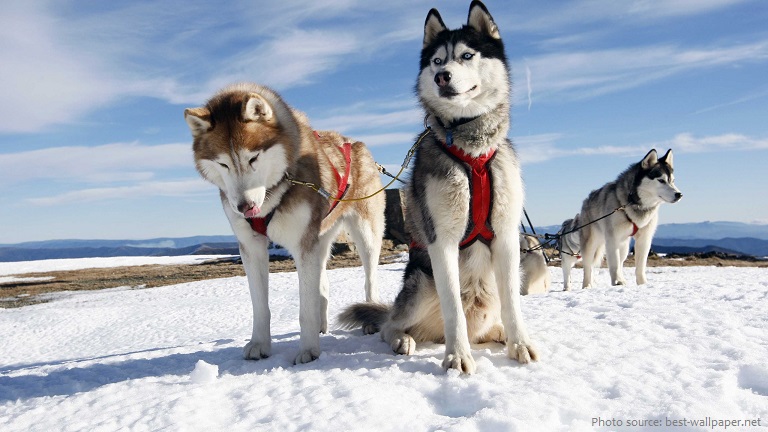
There are historical references to dogs used by Native American cultures dating back to before the first Europeans made land. There were two main types of sled dogs: one kept by coastal cultures and the other by people living in the interior. In the mid-1800s Russian traders following the Yukon River inland and acquired sled dogs from the villages along its shores.
Sled dogs were used to deliver the mail in Alaska during the late 1800s and early 1900s. Alaskan Malamutes were the favored breed, with teams averaging eight to 10 dogs. Dogs were capable of delivering mail in conditions that would stop boats, trains, and horses.
The first Arctic explorers were men with sled dogs. Due to the success of using sled dogs in the Arctic, it was thought they would be helpful in the Antarctic exploration as well, and many explorers made attempts to use them. Sled dogs were used until 1992, when they were banned from Antarctica by the Protocol on Environmental Protection to the Antarctic Treaty over concerns that the dogs might transfer diseases such as canine distemper to the seal population.

In 1925, a massive diphtheria outbreak crippled Nome, Alaska. There was no serum in Nome to treat the people infected by the disease. There was serum in Nenana, but the town was more than 970 km (600 mi) away, and inaccessible except by dog sled. A dog sled relay was set up by the villages between Nenana and Nome, and 20 teams worked together to relay the serum to Nome. The serum reached Nome in six days.
The Iditarod Trail was established on the path between these two towns. It was known as the Iditarod Trail because, at the time, Iditarod was the largest town on the trail.
The modern Iditarod is a 1,800 km (1,100 mi) endurance sled dog race. It usually lasts for ten to eleven days, weather permitting. It begins with a ceremonial start in Anchorage, Alaska on the morning of the first Saturday in March, with mushers running 32 km (20 mi) to Eagle River along the Alaskan Highway, giving spectators a chance to see the dogs and the mushers. The teams are then loaded onto trucks and driven 48 km (30 mi) to Wasilla for the official race start in the afternoon. The race ends when the last musher either drops out of the race or crosses the finish line in Nome. The winner of the race receives a prize of US$50,000. It has been billed as the “World Series of mushing events” and “The Last Great Race on Earth”.

The Alaskan Gold Rush brought renewed interest in the use of sled dogs as transportation. Most gold camps were accessible only by dogsled in the winter. “Everything that moved during the frozen season moved by dog team – prospectors, trappers, doctors, mail, commerce, trade, freighting of supplies … if it needed to move in winter, it was moved by sled dogs.” This, along with the dogs’ use in the exploration of the poles, led to the late 1800s and early 1900s being nicknamed the “Era of the Sled Dog”.
Sled dog teams delivered mail to rural communities in Alaska, Yukon, Northwest Territories and Nunavut.
Sled dogs today are still used by some rural communities, especially in areas of Russia, Canada, and Alaska as well as much of Greenland. They are used for recreational purposes and racing events, such as the Iditarod Trail and the Yukon Quest.
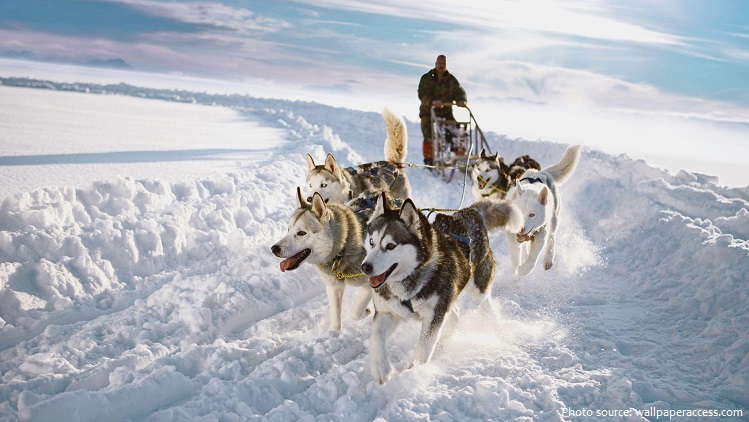
Sled dog racing is a winter dog sport most popular in the Arctic regions of the United States, Canada, Russia, Greenland and some European countries. It involves the timed competition of teams of sled dogs that pull a sled with the dog driver or musher standing on the runners. The team completing the marked course in the least time is judged the winner.
A sled dog race was a demonstration sport at the 1932 Winter Olympics in Lake Placid, New York and again at the Olympics in Oslo, and once more in the 1994 Winter Olympics in Lillehammer, but it did not gain official event status.
The most commonly used dog in dog sled racing, the Alaskan husky is a mongrel bred specifically for its performance as a sled dog.
Sled dog racing is Alaska’s official state sport. The Iditarod is the best-known race but there are dozens of dog races that take place during Alaska winters. Once a basic form of transportation, this popular activity has evolved into a recreational and competitive activity for both residents and tourists. Here’s more about how dog mushing became Alaska’s favorite sport!
